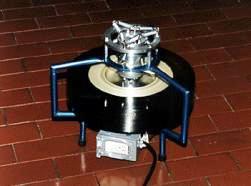Categories: Featured Articles » Interesting electrical news
Number of views: 59930
Comments on the article: 25
Super Flywheels - New Energy Storage Batteries
 They will not need to be brought in frosts at night in the heat. They will be much cheaper than ordinary ones, because plastic is cheaper than non-ferrous metals. Their service life will exceed the life of the machine itself. They will be charged from electric motors, from braking recovery energy, from stationary energy sources.
They will not need to be brought in frosts at night in the heat. They will be much cheaper than ordinary ones, because plastic is cheaper than non-ferrous metals. Their service life will exceed the life of the machine itself. They will be charged from electric motors, from braking recovery energy, from stationary energy sources.
it inertioids, or flywheels. They store energy and then give them to consumers as needed. With a large flywheel and internal combustion engine is not needed. Energy can also be stored at refueling stations, powering one or more flywheels with powerful electric motors. They are in a sealed airless space, and are suspended on powerful magnets.
They are called super flywheels, since they store energy thousands of times more than ordinary flywheels. They were invented 50 years ago by the Russian scientist N. Gulia, but they were not used en masse. Only a few artisanal developments - carts that replaced electric cars.
And now, on an industrial scale, this invention was reproduced in America. There, super-flywheels are installed in containers of 17 tons. And they can store and give up energy of 1.7 megawatts! They are used to stabilize power surges. In Russia, a single energy system does not need such stabilizers, since it works according to a more reliable scheme.
However, if use super flywheels in vehicles, construction, and wherever necessary, you can save almost half of the oil and gas used! There will be no need to warm up cold engines in the winter, just sat down and drove off.
Windmills of even small power can give great power, storing it in such energy storage. Just changed the flywheel in the car, or recharged it - spun the stopped flywheels and again you can go. Far and long.
Compared to electric accumulators Supermahoviki win in all respects. They are more durable, simpler and cheaper to manufacture, and, most importantly - environmentally friendly. And they store much more energy in times less time. Also give.
More flywheels can give power without transferring inertia to the body. For example, an electric drill of high power is trying to break out of hands due to inertia from a drill. If instead of installing an electric motor a flywheel is installed, it will drill with any force and almost keep itself in place. Moreover, the gyroscopic effect will facilitate the drilling of perfectly even holes, as on a machine. The untwisted flywheel of the drill will not allow it to vibrate in your hands.
In general, unprecedented energy convenience and other benefits of civilization await you. Only here someone needs to be done, or, as always, they will have to buy from there.
See also at bgv.electricianexp.com
:
